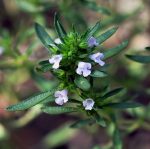 Summer savory is an annual and a member of the mint family , Lamiaceae, that also includes rosemary and thyme, and beebalm. It is native to southern Europe and the Mediterranean region but was brought to the new World by the early colonists as a medicinal herb and has naturalized there. Plants are 1 to 1 ½ feet tall and have finely hairy stems and soft hairless linear leaves about an inch long. The leaves are gray green at first but develop purple hues by late summer or early fall. They grow in pairs from the stem without petioles. The flowers are white or pale pink and two-lipped. They are ¼ inch long and are produced in clusters of three to six in upper leaf axils from mid summer to frost. The plant is bushy, highly aromatic with a sweet scent, and has a well-branched root system. Sumer savory does well in average, well-drained soil and full sun. The genus nam,e Satureja, is the Latin name for the plant and, according to the ancient Roman writer Pliny, is a derivative of the word for satyr because the herb belonged to the mythical creatures. The specific epithet, hortensis, comes from the Latin word hortus meaning garden, and refers to the cultivation of the plant in a garden.
Summer savory is an annual and a member of the mint family , Lamiaceae, that also includes rosemary and thyme, and beebalm. It is native to southern Europe and the Mediterranean region but was brought to the new World by the early colonists as a medicinal herb and has naturalized there. Plants are 1 to 1 ½ feet tall and have finely hairy stems and soft hairless linear leaves about an inch long. The leaves are gray green at first but develop purple hues by late summer or early fall. They grow in pairs from the stem without petioles. The flowers are white or pale pink and two-lipped. They are ¼ inch long and are produced in clusters of three to six in upper leaf axils from mid summer to frost. The plant is bushy, highly aromatic with a sweet scent, and has a well-branched root system. Sumer savory does well in average, well-drained soil and full sun. The genus nam,e Satureja, is the Latin name for the plant and, according to the ancient Roman writer Pliny, is a derivative of the word for satyr because the herb belonged to the mythical creatures. The specific epithet, hortensis, comes from the Latin word hortus meaning garden, and refers to the cultivation of the plant in a garden.
Summer savory has been used since ancient Roman times when it was used extensively in cooking. The Roman poet Virgil recommended that it be grown next to beehives because of the very fine honey made from its nectar. It may have been introduced into England in the time of Caesar and the Saxons called it savory because of its lively flavor. The Italians may have been the first to cultivate the herb and it is still an important ingredient in Italian cuisine. The 17th century herbalist Nicholas Culpepper wrote about the medicinal uses of the plant to treat a variety of ills from asthma to reproduction issues. The earliest colonists introduced savory to the New World in the early 1600s to treat indigestion and in John Josselyn’s book, New England Rarities, written in 1672, the presence of the herb in New England is mentioned. Many early New England cookbooks discuss its culinary uses. With a peppery thyme flavor, summer savory is tasty in teas, butter, and soups, as well as with eggs and many vegetables.
Photo Credit: Wikispecies